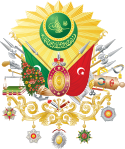Bajazyd II
 | |
Tugra Bajazyda II | |
 | |
| Sułtan Imperium Osmańskiego | |
| Okres | |
|---|---|
| Koronacja | 1481 |
| Poprzednik | |
| Następca | |
| Dane biograficzne | |
| Dynastia | |
| Data i miejsce urodzenia | 1447/48 |
| Data śmierci | |
| Ojciec | |
| Matka | |
| Rodzeństwo | Çem |
| Żona | Nigar Hatun |
| Dzieci | Selim I Groźny |
Bajazyd II (ur. 1447/1448 w Didimoticho w Tracji (ówczesne Dimetoka), zm. 26 maja 1512) – sułtan osmański od 1481 do 1512 roku. Syn Mehmeda Zdobywcy i Greczynki Emine Gülbahar.
Życiorys
Bajazyd miał brata Cema, z którym wygrał walkę o tron Imperium Osmańskiego.
25 kwietnia 1512 został zmuszony do abdykacji przez syna Selima I.
3 lipca 1503 Leonardo da Vinci wysłał do niego list, oferując mu swoje usługi inżynierskie. Oferował mu m.in. zbudowanie mostu w Konstantynopolu.
Media użyte na tej stronie
Every sultan of the Ottoman Empire had his own monogram, called the tughra, which served as a royal symbol. A coat of arms in the European heraldic sense was created in the late 19th century. Hampton Court requested from the Ottoman Empire a coat of arms to be included in their collection. As the coat of arms had not been previously used in the Ottoman Empire, it was designed after this request, and the final design was adopted by Sultan Abdul Hamid II on 17 April 1882.
Autor: Buho07, Licencja: CC BY-SA 3.0
Ottoman Imperial Standard, Late 19th and early 20th Century. Each Sultan had his own Tughra.
Tughra (i.e., seal or signature) of Bayezid II, Sultan of the Ottoman Empire (1481-1512). An explanation of the different elements composing the tughra can be found here.
Tughra (i.e., seal or signature) of Bayezid II, Sultan of the Ottoman Empire (1481-1512). An explanation of the different elements composing the tughra can be found here.
8th Sultan of the Ottoman Empire, Bayezid II (1447 - 1512).




